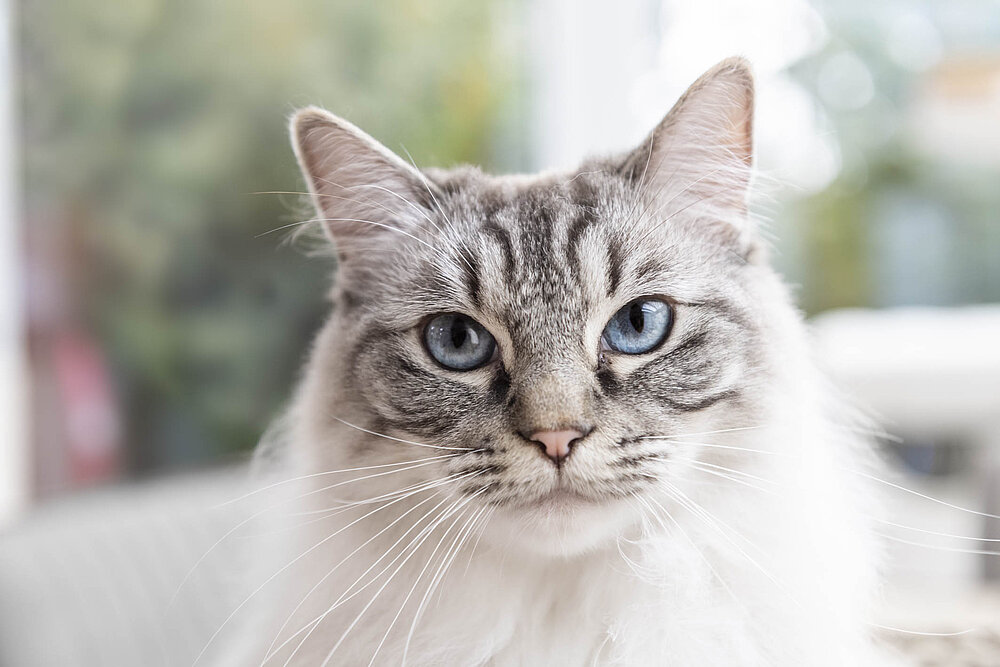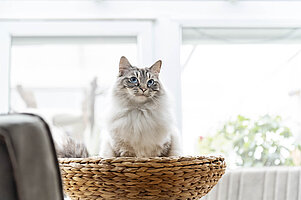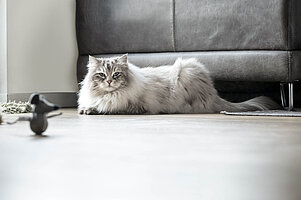
How to stop your cat from scent marking
Is your cat healthy and clearly marking its territory deliberately, not just because it needs the toilet? Then you can do the following to stop this behaviour.
Getting a cat to break its scent-marking habit can be a lengthy process – you therefore need a great deal of patience. Not to mention a good cleaning agent, as slight relapses can happen every now and again. It’s also important to have ruled out the possibility that, rather than marking its territory, your cat is simply not house-trained. Find out how to tell the difference here: Unwanted scent marking.
Don’t punish your pet!
Even though you might have the urge to do so, don’t punish your cat if you find or smell a puddle in your home. Your cat won’t understand the link between the punishment and its behaviour. In fact, punishing your cat at the wrong time could even make it afraid of you. You need to catch your cat ‘red-pawed’ to make it work. In this case, clapping your hands loudly and clearly saying “No!” is the right way to show your cat that its behaviour is not acceptable.
Clean properly
Cats like to mark the same place time and again. Here, you can take early preventive action by cleaning the scent-marked area thoroughly and effectively. For many cleaning products this is a real challenge, but Nature’s Miracle® is specialised in this. It contains active ingredients which break down odour components – that way neither you nor your cat will be able to detect the slightest hint of the malodorous message.
It’s extremely simple to use. If the urine stain is still wet, start by wiping up most of the liquid with (paper) towels then spray the area with Nature’s Miracle® Urine Remover. You now have 15 minutes to take a deep breath and calm down. Next, simply dab off the residue with a paper towel and Bob’s your uncle!
Find time to think about a potential long-term solution to the problem. Your vet is often a good person to contact and to offer support. Here are some possible solutions:
Have your cat neutered
If the culprits are male cats, in 90% of cases the problem of unwanted puddles can be resolved by having them neutered. For female cats, an operation can also get the marking problem under control. There is no guarantee that it will work, but it’s often worth a try.
More litter boxes
If you have several cats in one household, it may help if you increase the number of litter boxes. Many cats simply don’t like sharing their toilet with others. Furthermore, if your cat seems to like marking one place in particular, an additional litter box could be the solution. In general, you could also try giving your cat more ‘space’ of its own by increasing his living area, for example by giving it more vertical space (i.e. expanding upwards). There are some great ways of designing the walls to this effect.
Block the view
Is the very sight of other cats outside enough to make your cat spray? Then block its view into the garden. It’s important that you also clean any urine marking caused by other cats thoroughly so that the scent no longer triggers your cat – Nature’s Miracle® Urine Remover works wonders for this. In rare cases, you may have other cats enter your home through the cat flap and quite literally ‘create a stink’. In this case, a chip-controlled cat flap can help; otherwise close the cat flap at night.
Not here!
Sometimes cats have real favourite spots where they like to urinate. Block your cat’s access to any such places. It sometimes helps to move the furniture around a bit or to turn the pee spot into a feeding place. Generally speaking, cats don’t mark their feeding place. Some cat owners also place marbles, newspaper or even set (!) mouse traps in the affected areas. When the cat touches the trap, it snaps shut loudly and startles the cat. This generally puts cats off using their frequent marking spots.
Rub furniture with your cat’s scent
If you introduce a new object or item of furniture into your home, this may agitate your cat. Some cats may even ‘mark’ the new object in an unpleasant way. If your cat reacts this way, you could try allowing it to gradually get used to the new item of furniture. Keep it away from it until it no longer smells new. You could also rub it with your cat’s sent. Your cat has scent glands on its head, which it uses to spread its scent around your home (and onto you). Stroke your cat’s head with a cloth then rub it over the new object.
If your cat continues its undesired spraying despite all of your measures and thorough cleaning, it’s best to seek professional help. There are specific behaviour therapies, some of which involve the use of medication, which can help to solve the problem in the long term.
Sources:
-
Henry R. Askew: Treatment of Behaviour Problems in Dogs and Cats; Publisher : Wiley-Blackwell
-
Herz für Tiere: Katze markiert in der Wohnung (Abruf 24.08.2021);
https://herz-fuer-tiere.de/haustiere/katzen/verhalten-von-katzen/katze-markiert-in-der-wohnung -
https://www.tierklinik.de/ratgeber/fuer-katzenbesitzer/unsauberkeit-bei-katzen


